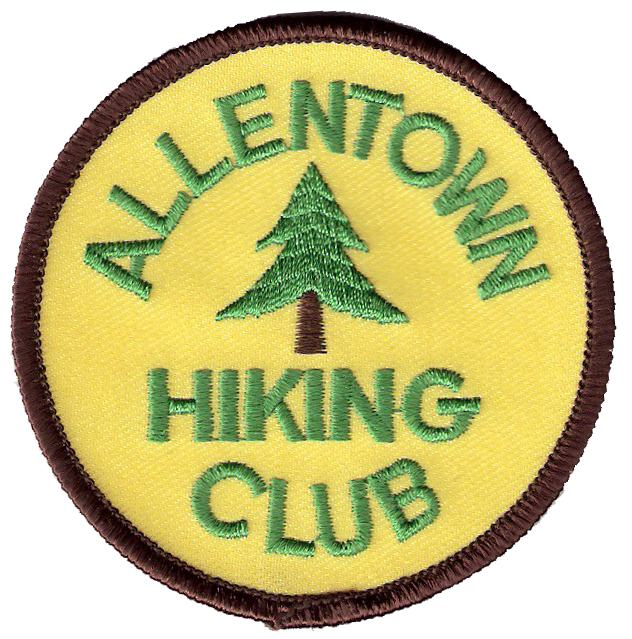

Allentown Hiking Club
The 1990s, Part 1: Appalachian Trail
An Allentown Hiking Club History
by Barbara L. Wiemann
by Barbara L. Wiemann
During the 1990s, as stewards of the Appalachian Trail, the Allentown Hiking Club improved and protected the Appalachian Trail experience for hikers by constructing trail relocations, installing a gate to prevent vehicular access to the trail, and constructing a privy and new shelter.
Gates and Relocations
Illegal vehicular traffic used the AT footpath east of PA 309 to access the ATT service road and drive to the power line near the New Tripoli campsite. As a result, that section of the AT was deeply rutted and extremely muddy and large quantities of trash accumulated at the campsite. In 1990, Frank Bertalan led the effort to install a locked gate between the AT and the service road, blocking this route to vehicles.
To finish the job, Bertalan and Ed Ritter directed a crew of 39 AHC volunteers who relocated the AT away from the muddy, rutted woods road and built a new access trail to the New Tripoli campsite. The old campsite side trail had descended straight down the ridge using the power line; the new trail, located in the woods east of the power line, switchbacks down to the campsite. The crew also re-piped the spring at the campsite.
In October 1993, Mike and Bev Wuerstle and Bertalan laid out a blue blazed trail skirting the restaurant parking lot at PA 309. This was planned as a "fall back" location for the AT in case any future owner of the restaurant did not want the trail on his or her property. (This section of trail crossing the parking lot was the only piece of AT that AHC maintained that was not within the National Park Service protected corridor). In 1996 this new trail became the official AT route and club members constructed 15 steps to connect the trail to PA 309; the old route to the restaurant became the side trail.
In July 1994, in response to a request from an adjacent landowner, three-quarters of a mile of AT footpath east of Jacksonville-Snyders Road was moved south, away from the NPS boundary closer to the center of the corridor. Under the leadership of Bertalan, Ritter, and Harold Croxton, the trail was built from "scratch to finish" in 4 hours. And that included blacking out the old blazes and closing the trail.
Privy and New Allentown Shelter
After completing these projects, the club turned its attention to the Allentown Shelter area. Years of increasingly heavy usage at the site pointed to the need for a privy, and the 60-year old Allentown Shelter was showing its age, requiring more repairs and hours to maintain. The August 1995 club meeting was devoted to a discussion of the future of the shelter and the need for a privy. Key points were the costs (of maintaining vs. building), demands that expected future usage would place on the structure and area, and the aesthetics of any projects.
Since sanitation was a major concern, the club moved forward immediately with plans for a clevis multrum privy. Permits from Lynn Township and the Game Commission were secured, as well a $1000 grant from LL Bean through the ATC Grants to Clubs program. Under the direction of Paul Shellenberger, club volunteers prefabricated the privy off site, dismantled it, and then reassembled it in June 1996. Twelve club volunteers contributed about 500 hours to the effort. Total cost was just over $1400.00.
With the new privy in place, club leadership turned full attention to replacing the Allentown Shelter. To fund this more expensive construction project, the club again applied for an LL Bean Grant through ATC (receiving $2800). Other major contributors were Pete Nestor, owner of Nestor Sporting Goods ($2000), and club member Earl Raul ($1000). These contribution covered the cost of the materials.
After securing this funding and the needed permits and approvals, work began in the winter of 1997. Mike Benyo led the March 9 work trip that dismantled the old shelter and prepared the site for the new structure. Ed Ritter directed the crew that cut the logs and pre-built the new milled log shelter at Resurrection Cemetery in Wescoesville. Every piece was numbered and driven to the shelter site. On the weekend of April 19-20, 34 club volunteers assembled the 8-foot by 14-foot shelter and secured the dark green metal roof. Finishing touches, such as the front steps, were added in May. In all, over 1000 hours of labor were contributed. On National Trails Day (June 7), AHC formally dedicated the shelter, concluding a very active decade of volunteer effort on behalf of the Appalachian Trail.